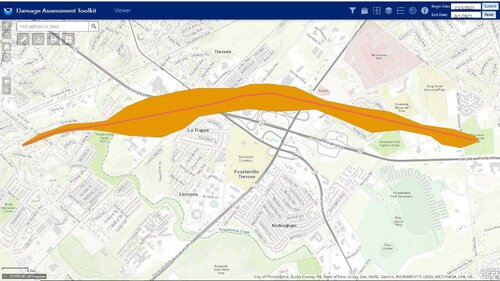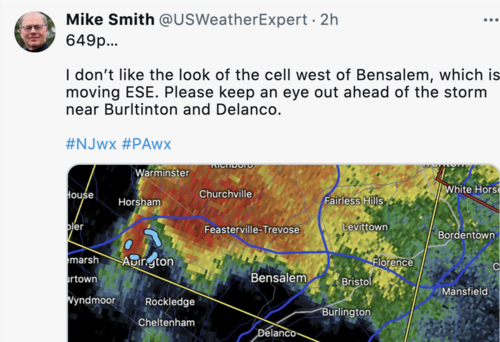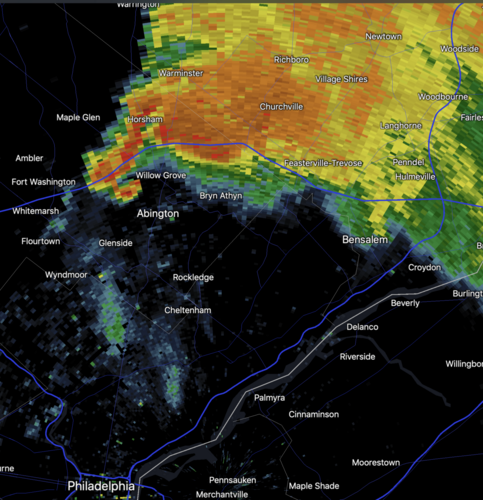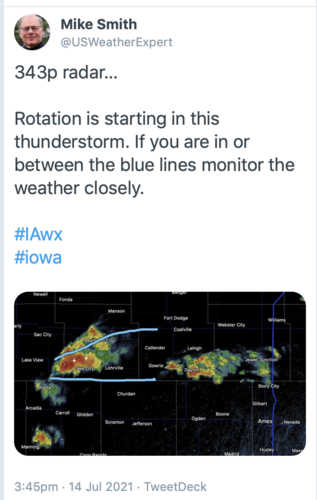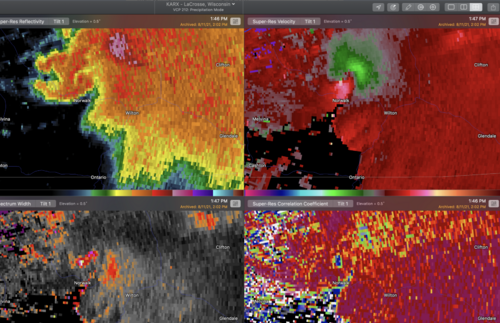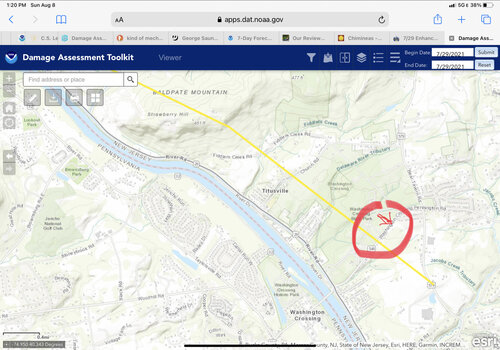To put it lightly, there's a lot of misinformation in this thread that needs to be clarified and checked. Not all of the comments below necessarily fall into that category.
but I always thought there was an algorithm that determines when the velocity couplet exceeds a threshold, so I’m not sure how there could be a deterioration in warning lead time, wouldn't this imply that someone was literally ignoring an alarm?? My understanding is that human intervention can issue a warning earlier than the threshold is exceeded, but not later ... But admittedly I don’t know too much about it, this is just my amateurish anecdotal understanding...
There are a couple of algorithms that have been developed over the years to assess the tornado potential of a storm. The only one that I know that is widely used currently is ProbTor, part of the recently developed suite of probabilistic severe guidance called
ProbSevere. "Widely used" is a generous term, as I don't want it to seem that NWS forecasters rely on this algorithm (or any algorithm) to determine whether or not to warn on a storm. If they do, they shouldn't be on the warning desk. However, it is one of many useful tools that can help forecasters determine the severe/tornado potential of a storm. Nothing beats "manual" radar analysis, though.
In the preceding two minutes, the inbounds greatly increased. So, we had a supercell's pendant echo that was starting to grow a hook between Horsham and Abington and a rapidly increasing couplet (likely from an increasing RFD).
If you're an NWS warning meteorologist and you issue a tornado warning on a supercell because it has a hook/pendant in reflectivity, you'll at least be removed from warning duties if you're lucky. To be a supercell, the updraft has to be spinning, which is typically going to lead to a hook. Not all supercells produce tornadoes. As for the velocity data at 2249z, there is no couplet there. What I see is cyclonic convergence, which can (not always) be associated with tornadogenesis in the near term.
Given it was the "tail-end Charlie"
There is
research that suggests a storm being the "tail-end Charlie" doesn't mean much for tornado potential. Interestingly, when the storm in question produced the tornado, it was no longer the tail-end storm, as another storm had formed in its updraft region, completely destroying any "classic" reflectivity signatures of the first storm. I believe this second storm produced the Bustleton EF0 that crossed Highway 1 and produced a hell of a debris ball for that weak of a tornado.
There is also
research that shows the unreliability of STP during the warm season.
it was a pretty easy warning. That a warning was obviously needed became even evident in the next few minutes as the Bensalem supercell was clearly a right mover.
Given all that was said above in addition to there was not really much of a well-defined, gate-to-gate couplet prior to tornadogenesis, no, it was not a "pretty easy warning". TPHL provided a little better of a look at the couplet, but both it and KDIX looked to be plagued by glitchy level II velocity data. TPHL did show what may have been a low-level current of air emanating from the forward flank toward the mesocyclone, which research has recently picked up on possibly being a pre-cursor to tornadogenesis. Also "a warning was obviously needed became even evident in the next few minutes" - hindsight is 20/20. This is a terrible bias we has humans have when reviewing past events. Of course it was evident - it happened. This train of thought can lead to poor decision making and missed opportunities to
properly learn. There are many books on this topic and how to think probabilistically.
Here's a good one.
Some NWS offices rely more heavily on various techniques and algorithms
Techniques...yes. Any time you issue a warning, you've applied a technique to do so. It's a matter of if an office (forecaster, really) is up on all the latest and greatest research...or if they're still several decades back issuing warnings based on hooks in reflectivity. Algorithms....just no.
The retirement of my generation of meteorologists and our expertise. This is especially true since we learned to warn tornadoes based on hooks, right-movers and other non-Doppler wind techniques. Given the funnel cloud report at 6:49pm along with the hook (see image) west of Bensalem at 6:47, it would have been an easy warning even without Doppler.
I've seen horrendous warnings produced by folks of your generation. Experience does not always equal expertise. Again, if you put a tornado warning on a storm just because it's a right mover and has a hook, you're going to be taken off the warning desk in today's world. Also, the number of false funnel reports far outweigh the real ones. Good luck going solely off that and how a storm looks in reflectivity.
The hiring of meteorologists fresh out of college. I am aware of multiple instances in three months where the NWS hired meteorologists who graduated in May, even when a more experienced candidate had applied.
As someone who graduated in 2019...oof. What the hell are fresh college grads expected to do? This sounds like the classic "Needs 10 years of experience" for an entry-level job. If you think that newly hired NWS mets hit the forecast and warning desk on their first day, you are very mistaken. It takes YEARS of training. Also, coming from someone who generally lacks confidence in many things (I don't know if I'm even good enough to have imposter syndrome

), I can say confidently that there are times (not all the time) when I can out-forecast and out-warn people who have been in the business longer than I've been living. Again, experience does not equal expertise.
Degradated radar training in the NWS. A person currently in the NWS, when discussing the tornado warning problem said to me, "Twenty years ago, radar training was a month in Kansas City. A decade ago, it was a week in Kansas City. Now, it is a couple of hours from the SOO." I don't know whether this is true everywhere or in all cases. But, if it is largely true, it is a serious issue.
Your source is either bitter about something and/or purposefully lying to you, or they are severely detached from how warning training is done. It takes over 100 hours of training that includes guided instruction from the SOO and facilitators in Norman BEFORE you can even get to the week long in-person training in Norman. This then is/should be complemented by at least yearly training from the SOO to ensure you are still up on your skills and the latest techniques and research.
Lack of attention. A quarter-century ago, the NWS worried about the weather wire and NOAA Weather Radio. Now, there is a tremendous amount of social media that has to be accomplished. Is this drawing attention away from mesoscale analysis and monitoring?
No. The warning meteorologist's sole duty is to warn on storms. They are not doing anything else. During severe weather, there is/should be someone dedicated to social media, comms, etc. If there is multi-tasking going on, it's not being done by the warning meteorologist.

